Photographs and Text by Norbert Schiller
This past September marked the 40th anniversary of the Grateful Dead concert at the Giza Pyramids in Egypt. The three-day event climaxed with a performance under a full lunar eclipse. The group’s fanatic followers, the Dead Heads, converged on Egypt from all over the world to revel in a three-day musical fest in the shadow of the Sphinx. Even though I neither attended the concert, nor was I a fan, the group’s performance indirectly altered the course of my life. The event also started a trend of performances at Egypt’s splendid archeological sites which I would document during my career as a photographer.
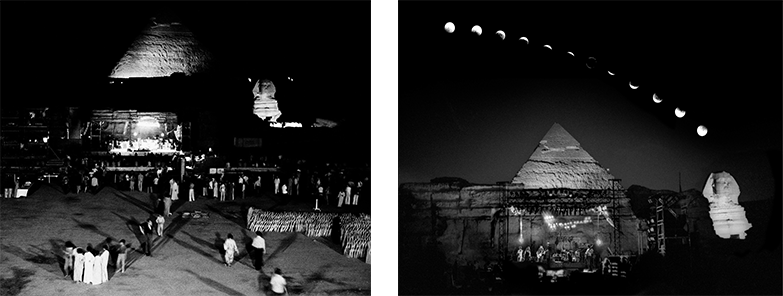
The Grateful Dead performing at the Sphinx and Pyramids of in September 1978. The last night was performed during a lunar eclipse which is shown here in time laps photography Phot. Adrian Boot
In February 1979, nearly five months after the Grateful Dead’s historic performance, I arrived in Athens for what I thought would be a short stop before going on to explore the Greek isles. I checked into a hostel and, while I was studying a map of the islands, two American students in their early 20s came into my room less than five minutes apart looking for travel partners to go to Egypt. After politely declining the invitations, I continued my research. I was soon interrupted by the commotion coming from one of the rooms down the hall. The noise and laughter were so loud that I had to get up to check what was happening. When I walked in, I found the two students, Steve and Hank, with a young couple from San Francisco who were preparing to fly to Cairo later that evening. The couple explained that they were fans of the Grateful Dead and had traveled to Egypt in September to attend all three concerts. Since they had loved Egypt so much, they were returning for another visit. As they were packing, they told funny stories about their time in Egypt and gave the other two tips on where to stay, and what to see and do once they arrived in Cairo. The excitement over this exotic place became hard to resist. “Do you mind if a third person joins you?” I asked.
“Hell no,” said Steve, “the more the merrier!”
With that, I abandoned my Greek archipelago odyssey and began preparing for my new journey to Egypt.
The Grateful Dead was the first major western rock group to perform in the shadow of the Giza Pyramids and the Sphinx. Before them, numerous musicians had posed for photos on the Giza Plateau, but the Grateful Dead was the first to perform and begin a trend that continues to this day. Less than a year after this inaugural concert, Frank Sinatra performed at the same venue, but to a much more upscale crowd.

Canadian American dancer Diana Calenti performing for a televisions crew below the Sphinx.
I was so enchanted by Egypt during the trip that I returned two years later to attend the American University in Cairo as an exchange student. After graduating from University of California at Santa Barbara in 1982, I went back, but this time to begin a career as a news photographer. One of the first assignments I had was to photograph the American Canadian dancer, Diana Calenti. The performer, who was already well known in dance circles in North America, had previously traveled to Egypt and was so enamored by the Sphinx that she choreographed a dance especially dedicated to the mythical creature and she wanted to perform it in Egypt. Calenti arrived with a local television crew and members of the press to the Giza Plateau at the crack of dawn, hoping to perform her dance while the sun was still low in the sky and the temperatures were cool. Unfortunately, she didn’t understand how things worked in Egypt. By the time the film crew had set up all the equipment, it was already mid-morning and the May sun was scorching. However, after a lot of false starts, sweat, and some tears, the dancer finally pulled it off, much to everyone’s relief. This was the first of many performances I would cover on the Giza Plateau during my next two decades in Egypt.

The setting for the 1987 Aida Opera in Luxor alongside an Aida performance at the Pyramids in mid-1990s
I dubbed 1987 the year of Opera Aida because two major productions were in the works to do something spectacular in Egypt. Verdi’s masterpiece, which had been commissioned by Khedive Ismail to celebrate the 1869 opening of the Suez Canal, was going to be performed again at the country’s spectacular sites to restore some of that past glory. The first show, which was scheduled in May at Luxor Temple, attracted 5,000 guests on opening night including Queen Sophia of Spain and Princess Caroline of Monaco. The setting was spectacular, but Placido Domingo, the featured tenor, was exacerbated by the poor acoustics at the temple. I can attest to that because when I attended, the wind carried the sounds upstream and those seated in the back rows could only hear the noise of the nearby streets. The second Aida was performed below the Sphinx in September to another star-studded crowd. Since the acoustics where much better there, the performance started a trend of Aida operas at the Giza Plateau throughout the 1990s. At one point, a semi permanent stage was set up west of the pyramids to hold regular performances as a way to attract tourists.

Shania Twain working with director Markus Blunder (wearing a white t-shirt) at the Giza Plateau
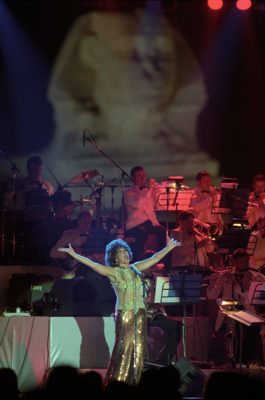
Shirley Bassey and her orchestra
Throughout the 1990s, the music television channel MTV, proved to be a good platform for up-and-coming artists such as country music singer Shania Twain. When Twain came out with her hit “The Woman in Me” in 1995, someone on her team suggested to film the video at the pyramids in Egypt, regardless of the fact that the song was unrelated to the location. The singer and her production team arrived in the middle of July, when temperatures were sizzling. However, that did not stop them from producing an amazing energy-filled video against this majestic backdrop. As the still photographer during the three-day shoot, I witnessed the star and her crew run amok amidst the pyramids and tombs as the video camera captured every imaginable shot of Twain including her racing across the desert on horseback. The video went on to win a number of awards including “Favorite Video of the Year Award,” a success which, in my opinion, was achieved partly due to the setting.
In 1998, Susanne Mubarak invited Shirley Bassey and her orchestra to perform at the Sphinx, as a way to raise funds for the first lady’s educational charity. According to the organizers, there were a lot of hurdles to overcome, most notably that the concert was to be held during the month-long fast of Ramadan. A day before the performance, many thought that the venue wouldn’t be ready. However, the next day everything was in order and the concert turned out to be a big success.
As the 20th century was drawing to a close, a tall, good looking young American of Egyptian origin arrived in Cairo with his equally stunning wife, a former New York model. My first encounter with Mohammed el Banna, or Mo has he liked to be called, was when I had an assignment to photograph him at the pyramids. Mo had made a name for himself shortly after arriving in Egypt due to his determination to produce the millennium celebrations at the pyramids. He threw around names like U2, Pink Floyd, and other rock bands as if they had already agreed to participate. All he still needed was the blessing of the Ministry of Culture and the other powers that be in Egypt.
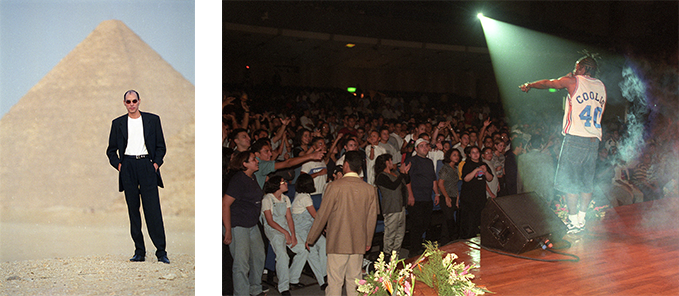
Mohammad El Banna (L) was determined to to produce the millennium concert at the pyramids. In preparation, he sponsored a few smaller acts including American rapper Coolio.
In order to promote his production company, Blue Nile, Mo sponsored smaller concerts at the Cairo Opera House and other venues. Because we got on well after our first meeting, he asked if I would be willing to take photographs of some of the events that he was promoting. My first job was to shoot publicity photographs of the Lebanese singer Majida el Roumi before she performed at the Opera House. The following event I photographed was a concert by American rap singer Coolio, best known for his song “Gangsta’s Paradise.” After two successful performances, things were looking up for Mo, but his winning streak was about to take a sudden plunge. I am not sure of the specific reasons for Mo’s demise, but I can only guess that there was no way the Egyptian hierarchy would have allowed an outsider take credit for a high stakes event such as the millennium celebrations on the world’s biggest stage. Rather than work with Mo, the authorities clipped his wings and he fell out of the sky shortly after taking off. In the end, Egypt’s powerful elite invited the musician Jean Michel Jarre to ring in the millennium on the Giza Plateau.
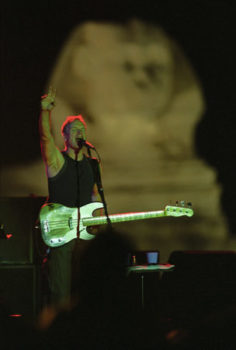
Sting rocks the Giza Plateau
The next big musical event at the pyramids was Sting, who performed with Algerian Rai singer Cheb Mami. The concert got off to a rocky start when Hakim, a local star who was supposed to open for the British artist, didn’t show up. After a 90-minute wait, a furious Sting was about to start the concert, when Hakim arrived claiming the stage. The organizers refused to let Hakim perform, but not before he got his hands on the microphone and began exciting the crowd. According to press reports, he yelled in the mic, “whoever is willing to accept the insult of an Egyptian in Egypt can stay. Goodbye!” With that, many in the audience began chanting “Hakim, Hakim, Hakim…” It wasn’t until the organizers explained to the crowd what had actually happened, that things calmed down so Sting could come on stage.
Beside the performing arts, the Giza Plateau has hosted other types of artistic events. One of the last stories I covered before moving out of Egypt in 2003, was an exhibition titled “Trash People” by German artist Ha Schult. The exhibit, which continues to travel around the world today, features hundreds of life size figures representing people made of trash. This effort is meant to draw attention to the global waste epidemic.
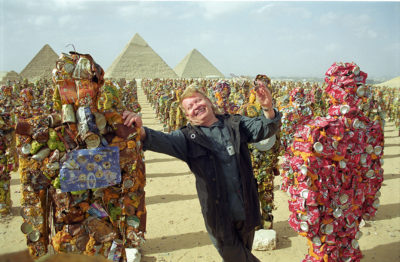
German artist Ha Schult and his Trash People on the Giza Plateau
Ten years ago, on the 30th anniversary of the Graceful Dead concert, the group finally released the long-anticipated music video and CD of their Egypt performance titled “Rocking The Cradle.” Numerous rumors have surfaced as to why it took three decades for this release. The most credible of these accounts is that during the first two of the three-day concerts, the crew had forgot to turn on the stage microphones. Therefore, in order to reconstruct the live versions of the performances, sound engineers had to rely on the recordings captured by microphones directed toward the audience. The only performance that had been properly recorded was the final portion featuring Nubian classical Oudist Hamza el Din. It wasn’t until new sound mixing technologies were discovered, that it became possible to eliminate the audience noise and enhance the sound coming from the musicians.
As I previously mentioned, I had never been a fan of the Grateful Dead but now, when I listen to “Rocking The Cradle,” a feeling of nostalgia comes over me and takes me back to that February evening in Athens when I abandoned the Greek isles for Egypt, where I would eventually start a new chapter that lasted 40 years.

Hello Norbert, nice to see your name and read your fascinating article, I remember you well.
Glad to come across this article and see my name and efforts credited for an unbelievable crazy task of pulling this off in Egypt. Yes, my wings got clipped by every bureaucrat in Cairo after the success Aida in 1998 and Majida EL Romi’s concert at the Opera House (BTW; she was the first ever solo singer to perform at the Main Hall of the Cairo Opera House) . The “Powerful” Minsters thought they can do it themselves thereafter, so in 1999 and after the stage was built and I am sure you are aware it was a massive failure (I was told they got army solders to fill the seats!!) and has been cancelled since.
So, they cancelled my 5 year contract which included New Years Eve 1999 which was the main reason I went back to Cairo since I secured Time Warners partnership to broadcast all my events including New Years Eve 1999.
I was told to my face by a Vice Minister who said ” what are you going to do, sue the government”!!, so instead of having Pink Floyd at the Pyramids on New Years Eve 1999, they opted to have JMJ since a “Minster” never heard of Pink Floyd, and I later found out that “a minster” was promised to exhibit his artwork at the Louver if JMJ ends up doing the millennial concert.
I can write a book about all this, but who has the time now…
I left my own country and swore to never venture there again,
If you ever decide to write a book or publish a story about your misadventures in Egypt attempting to produce the millennial concert I have the photographs to illustrate either! I think it’s a good idea.
Mo,
I am a UK citizen, living in NY, a professional violinist. I have produced concerts in crazy places like Bannerman Island with no electricity in the middle of the Hudson River, and my team suggested I produce a concert at the Giza pyramids in Egypt. I discarded the idea as being impossible as I had no contacts in Egypt, but somehow I couldn’t get the idea out of my mind. I finally took a plane to Cairo with a friend at the end of November 2021, and met a concert producer within 24 hours, who said she would help me. I fell completely and utterly in love with Egypt, I must have lived there for many past lives. We are now getting ready for our concert on November 4, 2022 at Kundalini Grand Pyramids. Will you come? Can we connect? It brings tears of sadness to my eyes that you swore never to venture there again, although I completely understand why. Maybe things are changing…maybe it is time for you to come back…